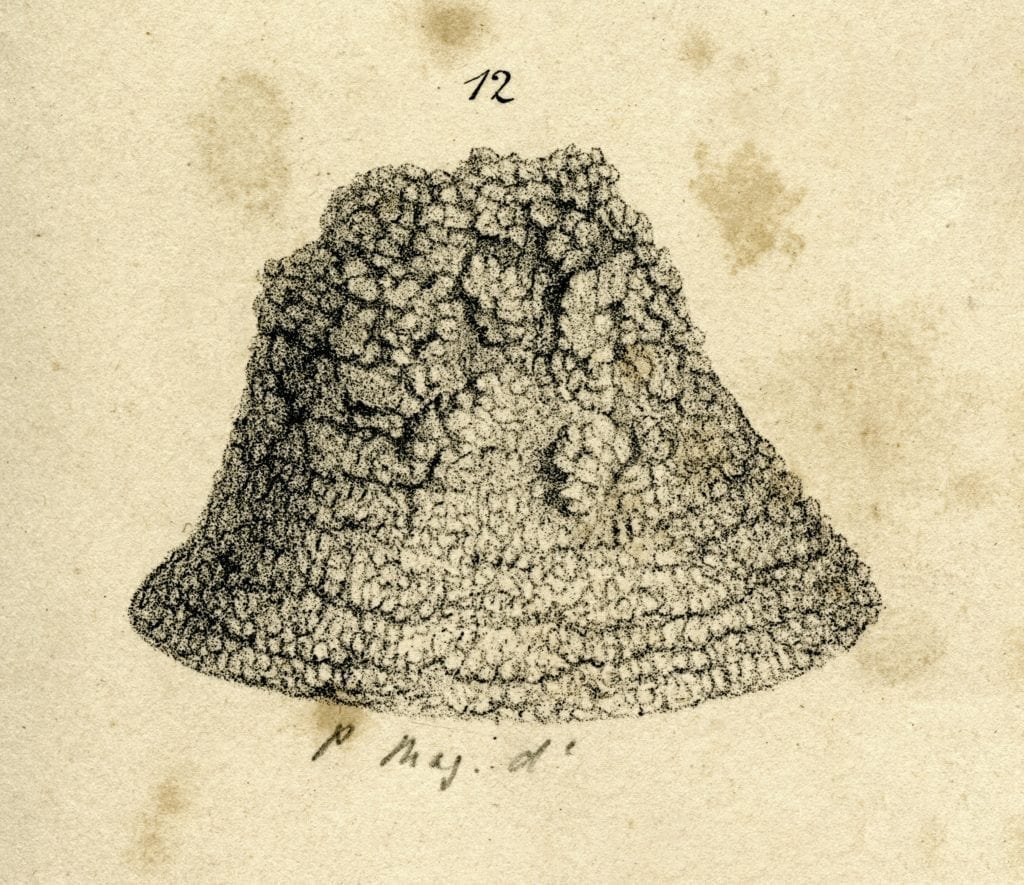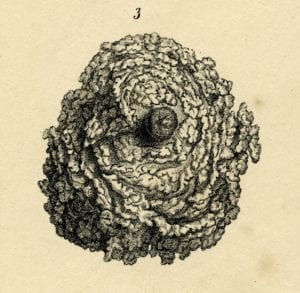Niamh Davies-Branch
Aberdeen, United Kingdom
 |
| A boiled gland with rose-like folds from Sir Astley Cooper’s Plates of the Anatomy of the Breast. Plates of the Anatomy of the Breast by Sir Astley Cooper in Sir Duncan Rice Library Special Collections, Aberdeen, UK |
John Keats, poet of the great odes, was also a surgical apprentice at Guy’s Hospital, London from October 1815 to March 1817.1 Although he never spent a day as a surgeon, he completed six years of medical and surgical training. During this period, he maintained an active literary life, composing thirty-nine poems2 while a student and surgical apprentice under the esteemed Sir Astley Cooper.3 Cooper is perhaps best known for his work On the Anatomy of the Female Breast, a lecture series documenting the surgical anatomy of the female body.4 He also taught anatomy and dissection at Guy’s Hospital as part of the surgical curriculum. Dissection is a “strongly visual and representation process,”5 which Amanda Taylor argues mirrors the process of anatomising bodies in poetry by way of “illustration and allegory.”6 The study of anatomy reduced a whole to its constituent parts as Taylor says, for “bodily knowledge.”7 Keats employs this anatomical gaze to dissect female bodies in his poetry, uncovering knowledge about their form and structure much like Cooper’s lecture notes do. The works of Cooper and Keats together offer insight into how and why female bodies were represented so differently from male anatomy in Victorian science and literature.
While learning under Cooper, Keats wrote “Calidore” and “To Mary Frogley,” two poems where he used natural allegory to capture elements of the female form, imbuing women with the passivity of nature. Both Keats and Cooper broke down the female body, displaying it through natural allegory as bodily fragments that were erotic, passive, and beautiful. Keats wrote “Calidore” in 1816, a poem featuring a hero adventuring across a lake towards a new, exciting land. From the start, Keats ensured “sweet-lipped”8 women were analogous with descriptions of the “sweet spot”9 of nature. Within the anatomical field, Ludmilla Jordanova notes how often nature was personified as a woman who was “unveiled, unclothed and penetrated by masculine science.”10 Cooper too personified nature as female, a woman looking out for the health of the body with “her restorative powers,”11 although she must still have “her ardour checked”12 by male science, which probes, cuts, and drugs her body. This use of natural allegory imposed a level of passivity onto the female form, which Alison Bashford describes as creating a “female-object-body,”13 while the anatomist retains his power as the “active male subject.”14 Bashford also distinguishes the anatomist’s gaze from other male gazes as being one-directional because “the dead body never looks back.”15 Likewise, Calidore’s “eye prepared to scan/ Nature’s clear beauty”16 without a returned glance, just as the anatomist has the “power to contemplate [the female] body for as long as he wants.”17
Many of Keats’s contemporaries have dubbed his use of natural imagery as “weak poetry of sensual excess.”18 However, Alan Bewell believes that Keats’s extensive use of natural imagery is a powerful literary device. By “looking at nature or flowers through Keats’s eyes, we begin to see a woman,”19 and represented by this botanical imagery is the “erotic desire and masculine authority”20 for the female form. The association with flowers, eroticism, and the female body have long been recognized within poetic circles, however anatomy has also made use of botanical metaphor. Cooper described the papillae, ligament suspensoria, and nipple gland as forming “petals, like those of a flower.”21 In the explanation of the breast anatomy plates, Cooper noted the “boiled gland…exhibiting rose-like folds”22 and pointed out the papillae had a “foliated appearance.”23 Bewell claims Keats saw nature as being “purposefully gathered, planted and arranged for display and pleasure”:24 an active process of control, and an attempt to harness erotic desire for the female form. In kind, Cooper’s anatomical knowledge of the dissected female form is “arrang[ed] for display and pleasure”25 through botanical metaphor.
 |
| Foliated appearance of the papillae of the nipple from Sir Astley Cooper’s Plates of the Anatomy of the Breast. Plates of the Anatomy of the Breast by Sir Astley Cooper in Sir Duncan Rice Library Special Collections, Aberdeen, UK |
Keats used botanical imagery in a similar way to represent the eroticized female form in his valentine poem “To Mary Frogley,” written by Keats in 1816 on behalf of his brother George, to be sent to a lady. While botany is a central feature of Romantic poetry, Donald Goellnicht argues that Keats’s medical education included a course on botany, which allowed him to incorporate botanical language in a more thorough way.26 While this influenced his general use of flowers in his poetry, studying anatomy under Cooper may have done more to evolve his use of botanical allegory for women and their bodies. Keats used botany in this poem to anatomize the female form, dissecting her into constituent parts. She has a “honeyed voice”27 and “dark hair that extends…as the leaves of hellebore,”28 which is a species of Christmas rose.29 Roses feature prominently in Cooper’s work on the female breast, and Goellnicht argues that it is “especially roses”30 that are used by Keats to show the “metaphorical connection between erotic passion and flowers.”31 The woman of this poem is part hellebore, lily, and water-lily, a whole garden “planted and arranged”32 by Keats, yet she also moves like a singular flower, in a “dainty bend”33 and “springing from a costly vase.”34 Keats both dissected the body and portrayed it as a whole, just as anatomy dissects to find knowledge about the entire body. Through his botanical dissection, Keats represented each part of the female body as a separate and erotic flower that together make up the whole desired woman.
Cooper saw the beauty in the function of the female form, molded by its anatomical structure. He described the “natural obliquity of the mamilla [as being] one of the most beautiful provisions of nature,”35 while the breast “forms a cushion”36 for the baby, which he calls us to admire for the “beauty and utility”37 of its anatomy. He believed careful surgical technique was of critical importance to prevent scars on women’s bodies that would render them “doomed to perpetual celibacy”38 on account of flawed, non-functional anatomy. This representation of women’s bodies is also seen in “To Mary Frogley.” Robert Gittings suggested this poem was influenced by William Hazlitt and his essay “On Beauty.”39 Hazlitt argued that beauty must be functional; the eyebrows of beautiful Greeks are “straight so as to sustain the lower part of the tablet of the forehead,”40 while the African face is less beautiful, according to Hazlitt, because the “eyebrows fly off slantways,”41 unable to hold the forehead as Greek eyebrows do. Hazlitt also included a passage noting that “motion is beautiful,”42 arguably because it implies functionality and ability. Throughout “To Mary Frogley,” Keats rendered her beauty in terms of movement and functionality. She has “eyes that dance,”43 her eyebrows are “leaning”44 and her locks of hair “bends,”45 “extends,”46 and “turn[s] to whence they sprung before.”47 Through the anatomical gaze, Keats and Cooper represented the functionality of the female form as beautiful, natural, and encouraged by male desire.
The study of anatomy and the influence of Sir Astley Cooper encouraged John Keats to explore bodies, and specifically female bodies, in a more anatomical light. Combining a Romantic poets’ love of nature with his anatomical gaze, Keats dissected his female characters, and represented their bodies as beautiful and passive. Allegorical use of nature and botany in “Calidore” and “To Mary Frogley” captured the beauty in the female body and the power held by the anatomical gaze in its construction of this beauty.
References
- Hrileena Ghosh, “John Keats ‘Guy’s Hospital’ Poetry,” In John Keats and the Medical Imagination, ed. Nicholas Roe (Switzerland: Palgrave Macmillan, 2017), 22.
- Ibid., 27.
- Joseph Epstein, “The Medical Keats,” The Hudson Review 52, no. 1 (1999): 50. Accessed April 9, 2019. doi:10.2307/3852571.
- Sir Astley Cooper, On the Anatomy of the Breast (London: Harrison and Co Printers, 1840), https://hdl.handle.net/2027/nyp.33433006447654
- Amanda Taylor, “The Compounded Body: Bodily Knowledge Production in the Works of Andreas Vesalius and Edmund Spenser,” Journal of Medieval and Early Modern Studies 48, no. 1 (2018): 153. Accessed April 9, 2019. doi:10.1215/10829636-4280891
- Ibid., 153.
- Ibid., 153
- John Keats, “Calidore,” in Keats: The Complete Poems, ed. Miriam Allott (London: Longman, 2011), 41, line 135.
- Ibid., 37, line 26.
- Ludmilla Jordanova, Sexual Visions: Images of Gender in Science and Medicine between the Eighteenth and Twentieth Century (UK: Harvester Wheatsheaf, 1989), 24.
- Cooper, On the Principles and Practice of Surgery, 22.
- Ibid., 14.
- Alison Bashford, Purity and Pollution: Gender, Embodiment and Victorian Medicine (UK: Macmillan Press, 1998), 108.
- Ibid., 108.
- Ibid., 115.
- Keats, “Calidore,” 38, lines 29-30.
- Bashford, Purity and Pollution, 115.
- Ibid., 71.
- Ibid., 80.
- Ibid., 80.
- Cooper, On the Anatomy of the Breast, 52.
- Ibid., 210.
- Ibid., 198.
- Alan Bewell, “Keats’s “Realm of Flora,”” Studies in Romanticism 31, no. 1 (1992): 74. Accessed April 9, 2019. doi:10.3138/9781442677647-006.
- Ibid., 74.
- Donald Goellnicht, The Poet-Physician: Keats and Medical Science (United States of America: University of Pittsburgh Press, 1984), 89.
- John Keats, “To Mary Frogley,” in Keats: The Complete Poems, ed. Miriam Allott (London: Longman, 2011), 30, line 24.
- Ibid., 29, lines 13-15.
- Ibid., 29.
- Goellnicht, The Poet-Physician, 102.
- Ibid., 102.
- Bewell, Keats’s “Realm of Flora,” 74.
- Keats, “To Mary Frogley, ” 29, line 9.
- Ibid., 31, line 55.
- Cooper, On the Anatomy of the Female Breast, 12.
- Ibid., 12.
- Ibid., 12.
- Sir Astley Cooper, The Lectures of Sir Astley Cooper, Baronet F.R.S Surgeon to the King, &c, on the Principles and Practice of Surgery, (Philadelphia: E. L. Carey & A. Hart, 1835), https://hdl.handle.net/2027/osu.32436000125110 82.
- Keats, “To Mary Frogley, ” 29.
- William Hazlitt, The Round table: a collection of essays on literature, men, and manners, (London: J. Templeman, 1841), https://hdl.handle.net/2027/nyp.33433112053347 145.
- Ibid., 145.
- Ibid., 148.
- Keats, “To Mary Frogley, ” 29, line 4.
- Ibid., 29, line 7.
- Ibid., 29, line 14
- Ibid., 29, line 13.
- Ibid., 30, line 16.
NIAMH DAVIES-BRANCH is a fifth-year medical student at the University of Aberdeen and is currently undertaking an intercalated year in Medical Humanities, with modules in Philosophy and English Literature.
Spring 2019 | Sections | Literary Essays

Leave a Reply